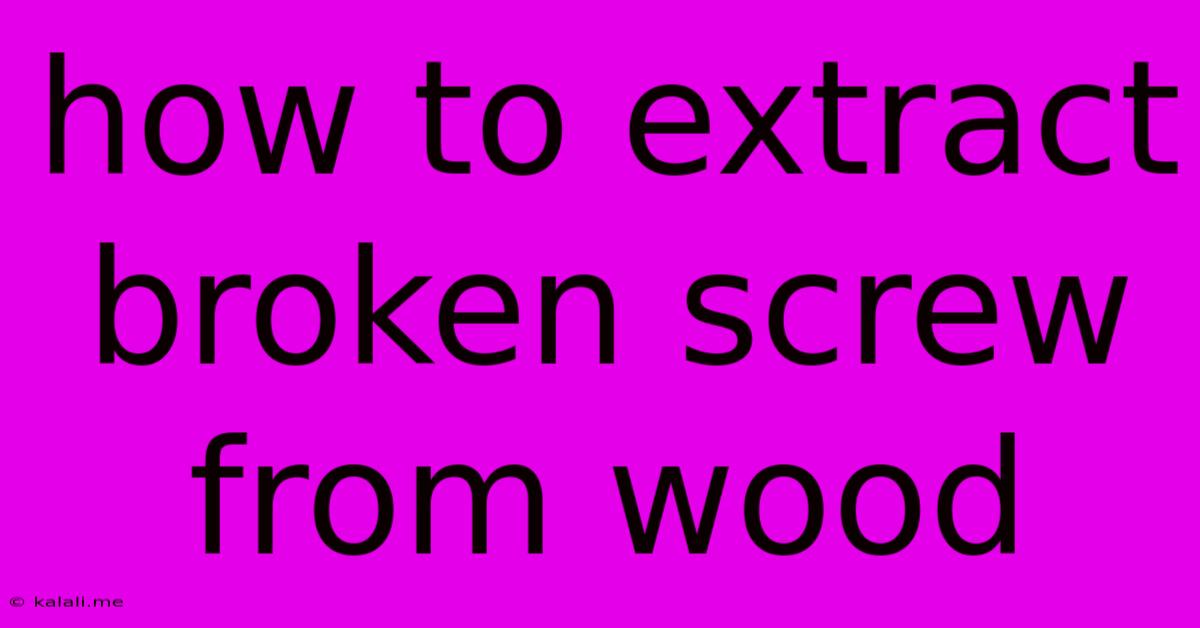How To Extract Broken Screw From Wood
Kalali
May 24, 2025 · 4 min read

Table of Contents
How to Extract a Broken Screw from Wood: A Comprehensive Guide
Removing a broken screw from wood can be frustrating, but with the right tools and techniques, it's entirely manageable. This guide covers various methods, from simple DIY solutions to more advanced techniques, ensuring you can tackle this common woodworking problem effectively. This article will cover everything from assessing the situation to choosing the right tool and finally, successfully removing that stubborn screw.
Why is this important? A broken screw can ruin a project, leaving you with a hole and an incomplete piece. Learning how to extract broken screws efficiently saves time, money, and frustration. This guide will help you avoid damaging the surrounding wood while efficiently removing the broken screw.
Assessing the Situation: What Kind of Screw is it?
Before you start, assess the situation. Several factors determine the best extraction method:
- Screw Type: Is it a wood screw, a machine screw, or something else? Wood screws often have a larger head and coarser threads.
- Screw Size: The diameter of the screw dictates the tool you'll need.
- How Much is Broken? Is just the head broken off, or is a significant portion of the screw still embedded?
- Wood Type: Hardwoods require more care to prevent splitting than softer woods.
- Location: Is the screw in a visible area? This might influence your choice of tools to minimize damage.
Methods for Removing Broken Screws:
Here are several methods, ranging from simple to more advanced:
1. Using a Screw Extractor:
This is often the most effective method, especially for deeply embedded or completely broken screws. Screw extractors are specialized tools with reverse-threaded bits that grip the broken screw and unscrew it.
- Choose the Right Size: Select an extractor slightly smaller than the broken screw.
- Drill a Pilot Hole: Carefully drill a pilot hole centered on the broken screw, using a drill bit slightly smaller than the extractor.
- Insert and Turn: Insert the extractor and turn it counterclockwise. Apply steady pressure; avoid forcing it. If it doesn't budge easily, try applying some penetrating oil.
2. Using a Hammer and Chisel:
This method is suitable for screws with a visible portion of the head remaining. It's less precise than an extractor but can work in a pinch.
- Create a Grip: Carefully chisel away the wood surrounding the broken screw to create a better grip.
- Insert the Chisel: Place the chisel against the remaining screw head and gently tap it with a hammer to loosen it. Work slowly and carefully to avoid damaging the surrounding wood.
3. Using Pliers or Vise Grips:
If a small portion of the screw head remains, you might be able to grip it with pliers or vise grips. However, this method may damage the surrounding wood.
- Securely Grip: Position the pliers or vise grips firmly onto the remaining screw head.
- Turn and Remove: Gently turn counterclockwise. Use caution to prevent slipping and damaging the wood.
4. Using a Reverse Drill Bit:
A reverse drill bit, also known as a left-hand drill bit, can sometimes work if a small portion of the screw remains. This method is risky and requires skill to avoid enlarging the hole unnecessarily.
- Select a Bit: Choose a bit slightly smaller than the screw diameter.
- Drill Slowly: Drill slowly and carefully, counterclockwise, to remove the screw. Be prepared to stop and reassess if you feel the bit slipping or damaging the wood.
5. Penetrating Oil:
Before attempting any extraction method, applying a penetrating oil like WD-40 can help loosen the screw, making extraction easier. Let it sit for some time before proceeding.
Prevention is Key:
The best way to avoid broken screws is to prevent them from happening in the first place. Here's how:
- Use the Right Size Drill Bit: Always pre-drill pilot holes appropriately sized for your screws.
- Avoid Over-Tightening: Don't force the screws; over-tightening can easily break them.
- Use a Good Quality Screwdriver: Ensure you're using a screwdriver that precisely matches the screw head.
By following these steps and choosing the appropriate method for your situation, you can successfully extract broken screws from wood, minimizing damage and completing your project successfully. Remember patience and careful technique are key to a clean result.
Latest Posts
Latest Posts
-
In Or On The Other Hand
May 25, 2025
-
If She Smokes She Pokes Meaning
May 25, 2025
-
Inverse Cdf Of Continuous Variable Is Continuous
May 25, 2025
-
Ssh No Matching Key Exchange Method Found
May 25, 2025
-
How To Get The Pokeflute In Pokemon Fire Red
May 25, 2025
Related Post
Thank you for visiting our website which covers about How To Extract Broken Screw From Wood . We hope the information provided has been useful to you. Feel free to contact us if you have any questions or need further assistance. See you next time and don't miss to bookmark.